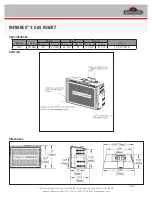
I
NSTALLATION
&
U
SERS
M
ANUAL
FIREPLACE
| SOL 60/70/80/90
15 |
Page
8.
L
IGHTING THE
F
IREPLACE
8.1.
Traditional method of lighting
Every time you light the fireplace, it initially requires large volumes of air. When the fireplace is cold, leave the door slightly open or secure the
handle
(Table 7.2.1, Line 2)
at the first stop in order for air to circulate around the door for the first few minutes and turn the automatic
combustion air regulator
(Table 7.2.1, line 4)
on position 9.
To form an adequate layer of ash at the base of the fireplace, use 1-2 kg of dry kindling the first time you light it. If it is possible, constantly
maintain a layer of ash with thickness of 2-3 cm at the base of the combustion chamber for added insulation.
1.
Place 2-4 kindling tablets or 7-10 wrapped newspaper sheets beneath 1-2 kg dry kindling.
2.
Turn the automatic combustion air regulator
(Table 7.2.1, line 4)
on position 9.
3.
After the the ignition of the tablets/wrapped sheets, leave the door slightly open or secure the handle
(Table 7.2.1, Line 2)
at the first stop,
in order to ensure an adequate convection of the flue.
4.
Once you ensure the flue is warm enough (after 5-10 minutes), close the door. If all required conditions are met, after 15-20 minutes a thick
layer of cinder will be formed in the combustion chamber and the temperature will rise, which is essential for the continuation of
combustion.
5.
Once the requirement described in point 4 is met, place 2-3 logs with overall weight of 1.5-4.8kg, depending on the size of the fireplace, on
the cinder, with a distance of about 1cm from one another.
6.
Open the air supply to the maximum level and close the door. The wood will begin to burn within 2-3 minutes. If not, open the door slightly
in order for enough air for combustion to enter. Close the door again once the wood ignites.
7.
Lower the automatic combustion air regulator
(Table 7.2.1, line 4)
between positions 5 to 7, so that the combustion continues seamleassly
and ensure there is adequate air supply (oxygen) to maintain the flame clear and powerful when you reduce the amount of combustion
air and after.
8.
As soon as the fire leaves a thick layer of cinder, you can add more firewood by repeating steps 5-7, every 45-55 minutes according to the
type of the device.
8.2.
Lighting without CO emissions (FROM TOP TO BOTTOM)
1.
Turn the automatic combustion air regulator
(Table 7.2.1, line 4)
on position 9. If needed, leave the door slightly open or secure the handle
(Table 7.2.1, Line 2)
at the first stop, in order to ensure an adequate convection of the flue.
2.
Place 2-3 logs with overall weight of 1.5-4.8kg and 30-60cm, depending on the size of the fireplace.
3.
Place 2-3 kindling tablets or 5-8 wrapped newspaper sheets between the logs.
4.
Add a few twigs (1-2 kg) on the top in zigzag arrangement.
5.
Finally, place a medium log on top of the stack and light the tablets/wrapped sheets.
6.
Once you ensure the flue is warm enough (after 5-10 minutes), close the door.
7.
Lower the automatic combustion air regulator
(Table 7.2.1, line 4)
between positions 5 to 7, so that the combustion continues seamleassly
and ensure there is adequate air supply (oxygen) to maintain the flame clear and powerful when you reduce the amount of combustion
air and after.
8.
As soon as the fire leaves a thick layer of cinder, you can add more firewood, every 45-55 minutes according to the type of the device..
Feed the fireplace often but with small amounts of firewood, at most 1.5-4.8kg, depending on the size of the fireplace, each time. If the
fireplace is overly full, t he generated heat may cause excessive strain on the flue. The supply of firewood should be done in moderation.
The openings of the secondary air supply
should not be covered by firewood.
To avoid covering the glass with soot, it is
important not to let logs lean against it.
Don’t leave the fireplace unattended as long as the door remains open.
Due to the self-closing door you should be very careful for
any accidents during the fueling of the fireplace.
Summary of Contents for SOL 60
Page 1: ......
Page 25: ...INSTALLATION USERS MANUAL FIREPLACE SOL 60 70 80 90 24 Page NOTES S N...
Page 26: ......











































